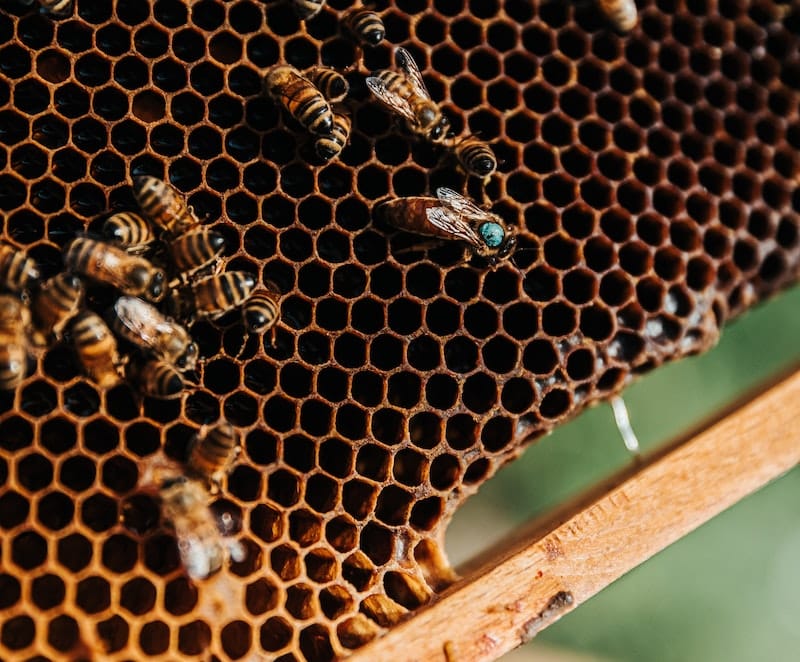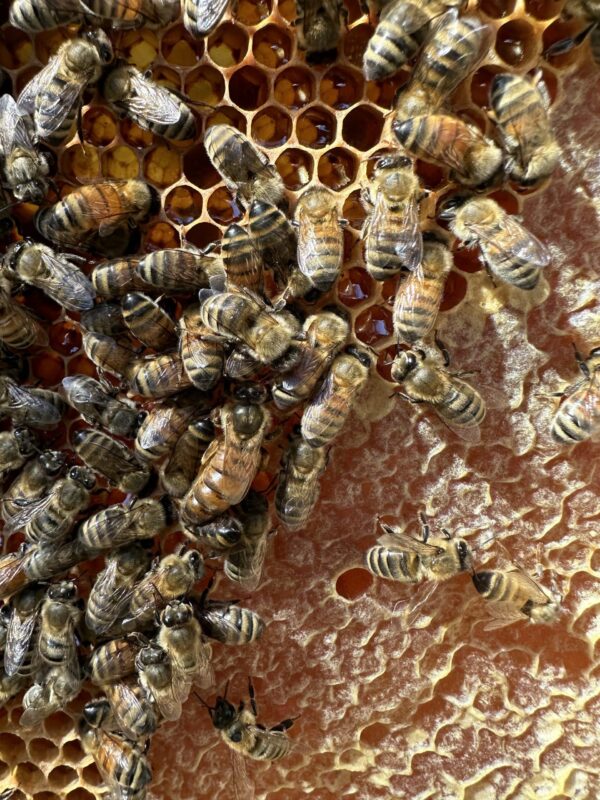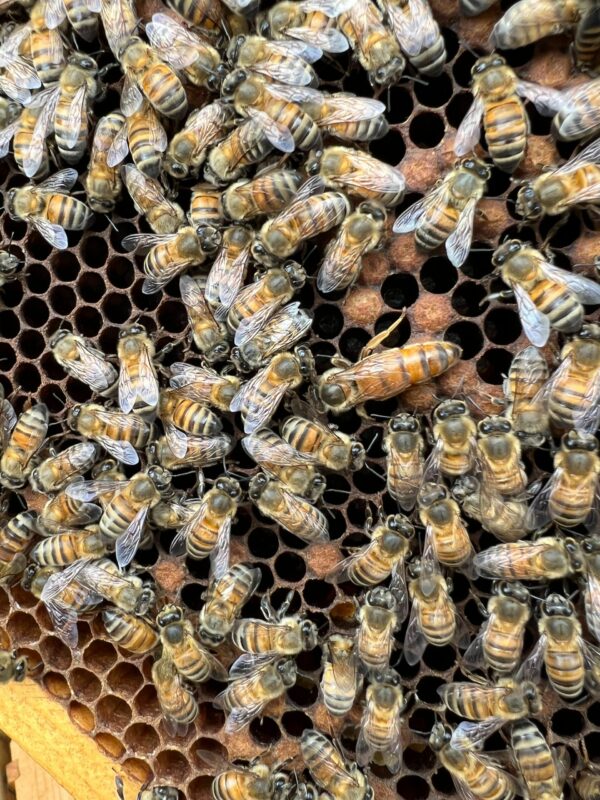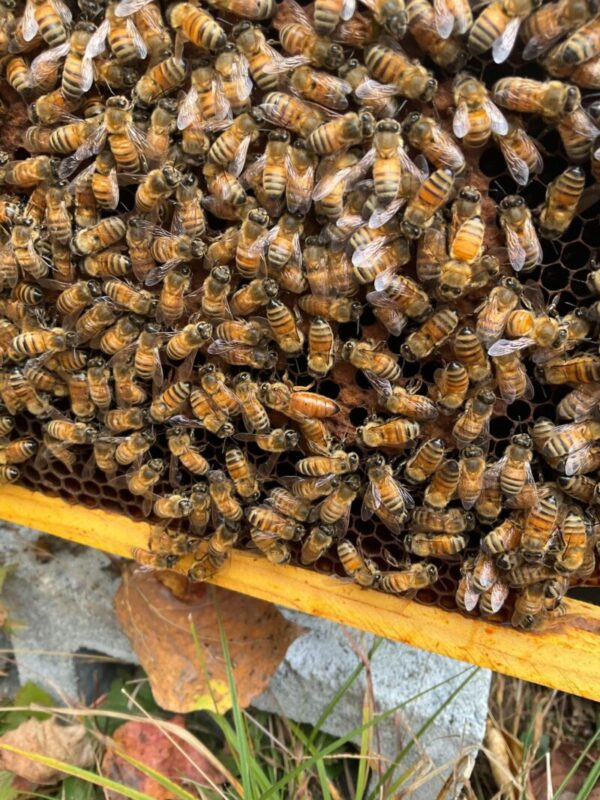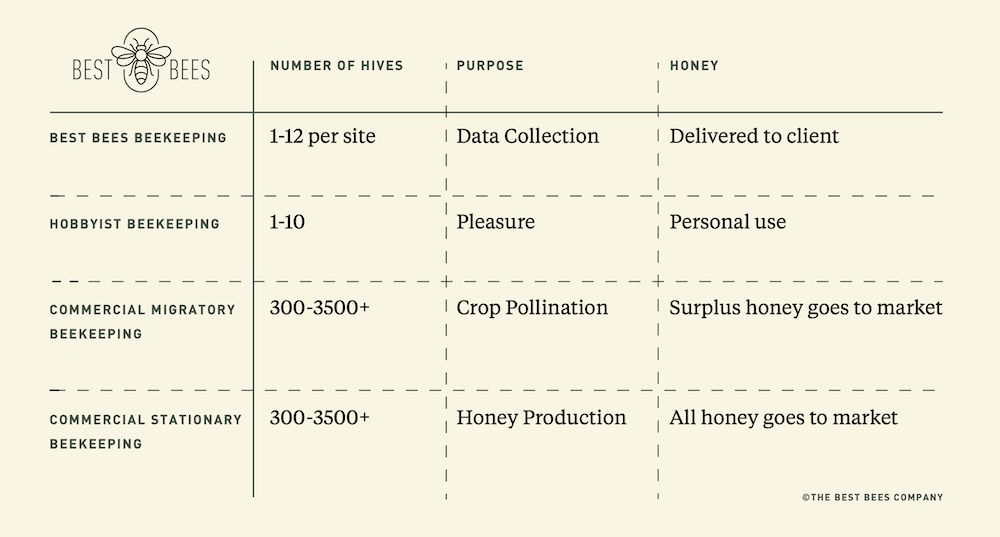Contents
Updated February 12, 2024
- What is a Queen Bee?
- Types of Queen Bees
- 5 Quick Facts about Honey Bee Queens
- What Does a Queen Bee Look Like?
- How is a Queen Bee Born?
- Mating Behavior of a Honey Bee Queen
- How are Queen Bees and Worker Bees Different?
- What is the Queen Bee’s Role in a Hive?
- How does a Queen Bee Reproduce?
- A Queen Bee’s Role in Swarming
- Supersedure of the Queen
- What Happens when a Queen Bee Dies?
- What is Queen Rearing?
- 4 Pictures of Honey Bee Queens
- FAQs
What is a Queen Bee?
A queen bee is known as the “mother” of all the bees in one hive and is an adult, mated female bee. The survival and success of one colony are entirely dependent on the queen, and her role within the hive is incredibly important.
Types of Queen Bees
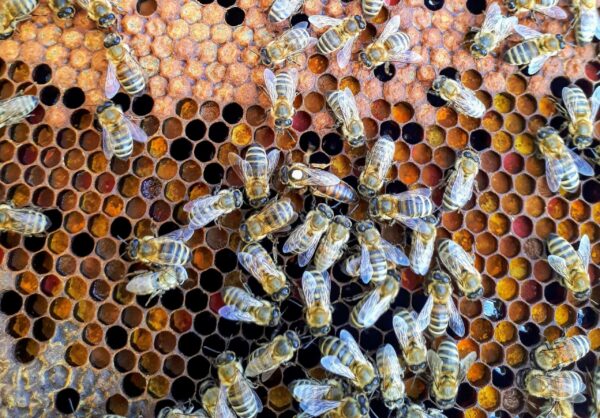
There are various types of queen bees, but it is important to know that not all bees live in a hive with a queen. The most commonly recognized queen bee lives in a hive of honey bees, although bumble bees and even some types of wasps have queens as well. According to The Conversation, wasp and bee species with queens are called social insects, as they live together in large groups ranging from 100 to over 50,000 and work together to raise the young.
5 Quick Facts about Honey Bee Queens
- Honey bee queens live an average of two to three years, but have been known to live up to five.
- A healthy honey bee queen can lay up to 2,000 eggs per day.
- The queen bee is the only caste within the honey bee hive that is fed royal jelly throughout her larval phase.
- The queen bee is the largest in the colony, around 20mm in size.
- A queen bee’s stinger is smooth, unlike a worker bee’s, which is barbed. This allows her to sting multiple times and survive.
What Does a Queen Bee Look Like?
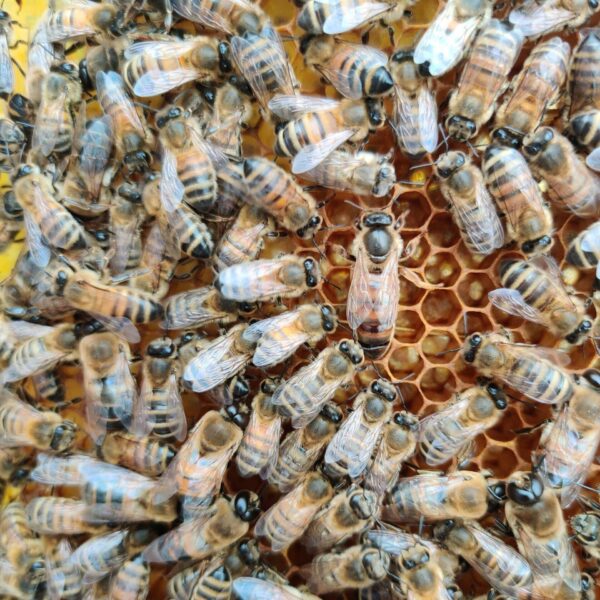
A queen bee is slightly larger than the rest of the bees in her colony, and she can typically be first spotted by her larger abdomen. The queen bee is larger than the workers. She emerges from her cell soft and fuzzy and remains that way for a day or so, allowing her body to darken and harden, as all newborn bees must.
Beekeeping Like A Girl also notes that queens can be a range of colors and the paint on marked queens can wear off over time. During the practice of beekeeping, the queen is often marked with a spot of paint on her back, which helps beekeepers identify the queen more quickly and easily.
How is a Queen Bee Born?
Just a few eggs are laid in specially constructed queen cups. Queen cups are wax dome-shaped cups intended to contain an egg for a future queen. Once the cup has been developed and an egg is present, the nurse bees will draw out the comb to create a queen cell; these are vertically oriented wax structures that look almost like a peanut shell.
The queen’s DNA is no different from that of her worker-bee sisters; the only difference is environmental. Royal jelly is a secretion produced by the workers and fed to all larvae for the first three days. After the workers and drones are switched to bee bread, the queen continues to be fed royal jelly throughout her larval phase, enabling her reproductive organs to develop fully. Simply because of a change in diet, her life is changed forever. She will live for years, rather than a month, and she may lay several hundred thousand eggs over her lifetime, rather than none.
Mating Behavior of Honey Bee Queens
Virgin queens typically mate between 8 and 12 days after emergence, but this is highly variable depending on the weather – temperatures must be at least 69 degrees F with minimal wind. Given the conditions are right, the queen bee will take off on the first of up to three mating flights. She will fly high to find her mates in areas where drones congregate.
Honey bee queens are notorious for mating with more males than possibly any other animal on earth – genetic analyses have shown up to 29 different paternal lines within one queen’s hive. Her reproductive organs include a spermatheca. This organ stores the sperm she collects on her mating flights, and will fertilize all the eggs she will lay for the rest of her life.
How are Queen Bees and Worker Bees Different?
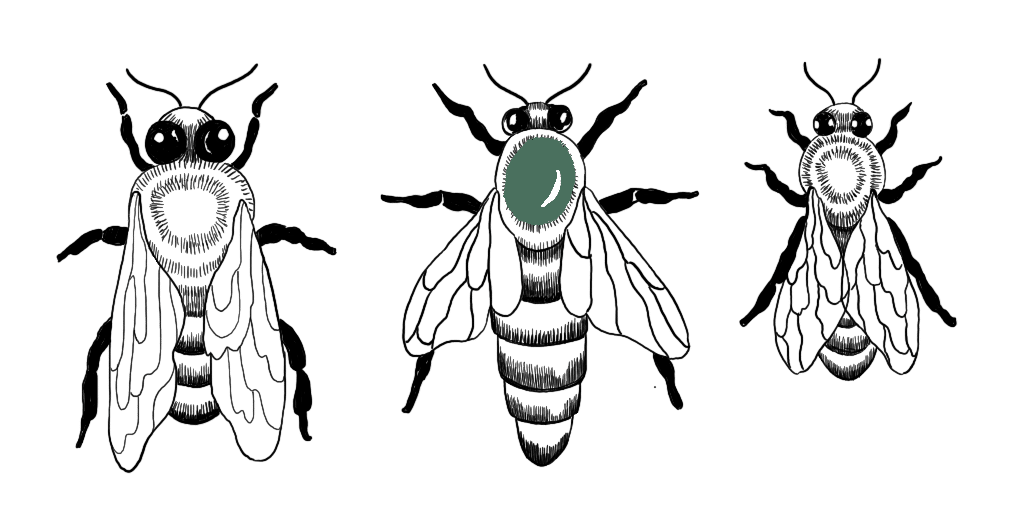
In order for the colony to survive, a queen bee must lay eggs – because when she does, worker bees are created. Worker bees are truly the life force inside any hive, as they are the ones who forage for food and take care of the entire colony. In terms of honey bees, worker bees are the smallest in the hive, and when the worker bee is young, she takes on the role of the nurse bee and will process incoming nectar, feed the queen, as well as make and cap any honey. When worker bees become older, they will leave the hive each day to collect the nutrients and resources that the colony needs to survive.
What is the Queen Bee’s Role in a Hive?

Since the queen bee is the only female in the hive with fully developed ovaries, she plays two key roles within the hive: to lay eggs and to regulate the colony through the use of chemical scents, called pheromones. Throughout her life in the hive (which is 2-3 years, on average), the queen will give off a specific pheromone known as Queen Mandibular Pheromone, or QMP. This scent helps the worker bees understand if the colony needs a new queen, or if duties can continue on as normal.
QMP promotes worker unity and cohesion. This means all of the workers are secure and able to focus on their various roles within the hive, from foraging to honey production to nursing brood to building comb. This keeps the colony functioning smoothly. This pheromone also inhibits worker reproduction (laying workers) and prevents the rearing of new queens, avoiding multiple queens at once within the hive.
How Does a Queen Bee Reproduce?
Once the queen bee has mated, she will return to the hive and live there for the rest of her life. During this time, she will also travel through the hive, looking for empty brood cells in which she can lay two types of eggs (fertilized and unfertilized). The fertilized eggs in the cell will become female worker bees, while the unfertilized eggs will hatch into drones or male honey bees.
A Queen Bee’s Role in Swarming
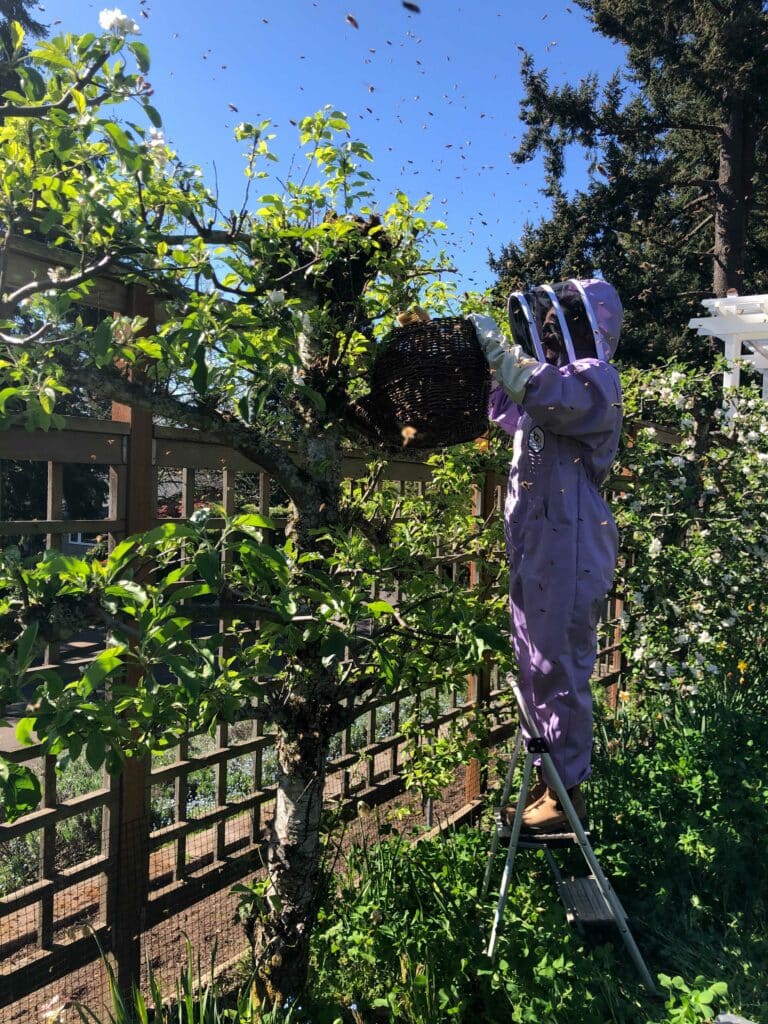
If you’ve ever seen a cluster of bees outside their hives or flying in a massive cloud, then you’ve witnessed a swarm! Swarming is the process in which bees reproduce to form new colonies, and can occur for the following reasons:
- The colony has outgrown its current home and run out of space to store honey and brood.
- The hive itself has become too congested and can no longer be regulated by one queen’s pheromones.
- External conditions have raised the internal temperature and humidity within the hive.
When a colony’s population grows too large, they may run out of room in the hive, prompting them to start the process of swarming – basically, splitting the colony in two. Half of the colony will leave with the old queen, while the other half will stay behind with a newly reared queen. Another aspect of rapid population growth is that when the hive is densely populated, there’s more body heat and less ventilation, which can lead to a hot and humid hive. External conditions can have this effect as well; scorching, super humid weather can lead the bees to swarm, as they try to alleviate those unpleasant hive conditions.
Earlier, we talked about pheromones and, specifically, Queen Mandibular Pheromone. When the hive is too densely populated for the queen bee’s pheromones to control the entire workforce, the colony can not function properly. One function of QMP is to suppress queen rearing; if not all the workers are receiving this message, they will signal that it is time to swarm and start the process of developing new queens. To learn more about the swarm process, check out our “All About A Honey Bee Swarm: Everything You Need To Know” blog.
Supersedure of the Queen
A honey bee colony only has one queen. In many ways, her health and performance determines the health of the colony. There are a handful of reasons a colony may reject their queen and choose to overthrow her:
- Decreasing egg laying rates
- Diminishing pheromones
- Bad brood pattern
- Hive stress
- The queen is old
Bee brood, as a reminder, refers to young developing bees. They start as eggs, which is the queen bee’s job to produce. Brood gives off a pheromone of its own that the workers monitor, and if the pheromone levels are not up to par, the workers take it as an indication of a failing queen. They make take it upon themselves to kill her and raise a more prolific egg layer.
Earlier, we talked about Queen Mandibular Pheromone, which inhibits worker reproduction and suppresses queen rearing. As the queen ages, her pheromones naturally begin to decrease. If the workers don’t detect this pheromone, they will start to raise her replacement.
What Happens when a Queen Bee Dies?
If a colony’s original queen dies, its worker bees notice the lack of pheromones, which means it’s time to replace that queen with a new one. Once the worker bees know that there is a reduction in pheromones, they start building queen cells, which are larger than the cells that are typically used to hatch worker bees. Inside these larger cells, potential queen bees are fed royal jelly and over time a new potential queen is born.
After that, it’s a matter of survival of the fittest: after emerging from her cell, a new queen bee will instinctively set out to kill her sisters – her competition for the throne. She will call to them by ‘piping’, repeatedly emitting a high-pitched chirp. The other new queens will pipe back so they can find each other to fight to the death. Queen bees still in their queen cells will pipe back as well, empowering the queen that’s out and about to sting them to death before they’ve even hatched.
Once she has successfully eliminated her competitors, the new virgin queen will conduct the mating flight we discussed earlier in this article. Once she’s back in the hive, she will get started laying eggs and enforcing colony cohesion.
What is Queen Rearing?
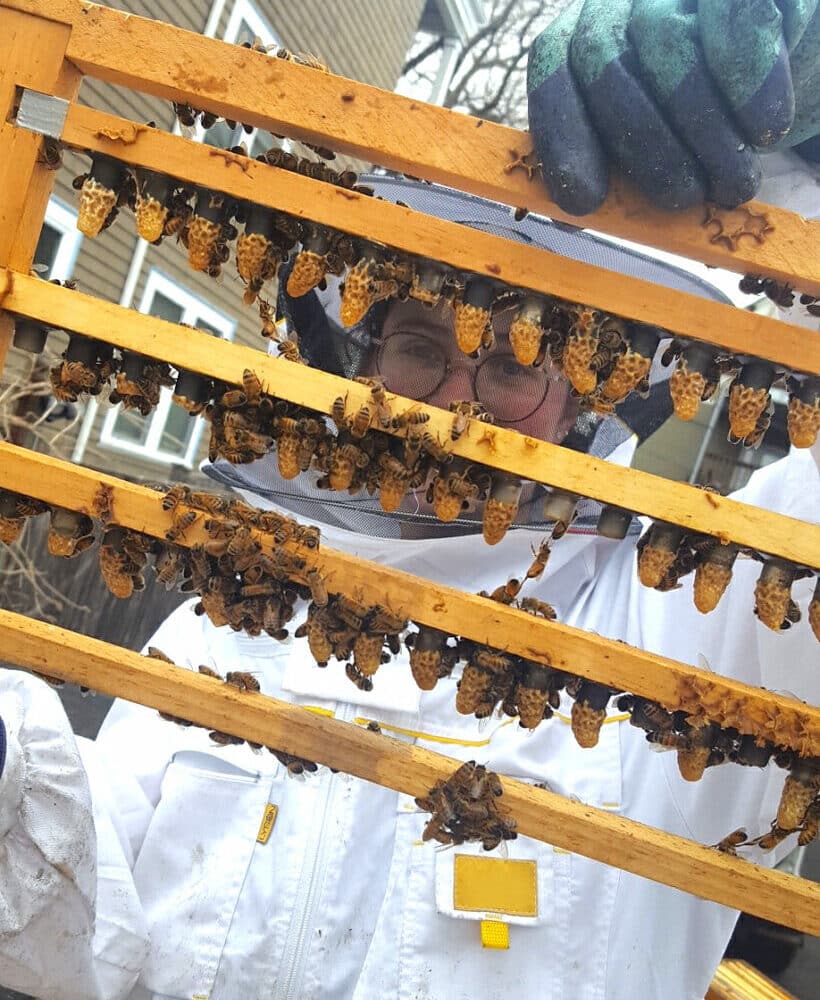
Queen rearing is the process of inducing a colony to produce new queens by manipulating various colony attributes. Queen rearing allows for easy access to replacement queens, increased colony numbers, more control over genetics, increased colony productivity, and increased self-sufficiency. The most common approach to queen rearing is known as grafting. Grafting is usually done when hives are on the verge of swarming—when they are near capacity, and plenty of drones are available.
A portion of the selected hive, known as a “split”, is taken from brood frames, as these are full of both larvae and nurse bees, and placed in a nuc (short for nucleus colony)—a smaller bee box ideal for queen rearing. Young larvae are then removed by special grafting tools and placed into queen cups in a separate strong, queenless colony full of nurse bees to feed them royal jelly and build them into queen cells. Before emergence, individual queen cells are then removed and placed in mating nucs where they can be fed and cared for until mating time. After 10-14 days the larvae ripen and are ready to emerge as functioning queens.
4 Pictures of Honey Bee Queens
FAQS
Q: Does a queen bee sting?
A: Yes, but the unbarbed stinger of the queen allows her to sting more than once, but she uses it only to kill other queens within the hive and to gain her place at the center of the colony.
Q: What’s the difference between a queen bee and a worker bee?
A: A queen bee lays eggs and gives off a chemical scent to worker bees that helps them understand the health and productivity of their colony. Worker bees forage for food and take care of the entire colony, including the queen.
Q: How can you spot a queen bee?
A: You can spot a queen bee in a hive by noticing its larger abdomen and overall size compared to the workers and drones. The queen is also usually surrounded by the worker bees, and beekeepers often place a dot of paint on the back of the queen bees to help identify them more easily.


